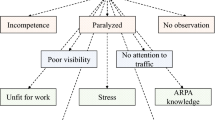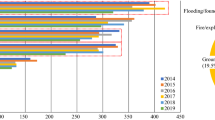Abstract
The purpose of this paper is to study the effect of selected parameters in ship collision and extend it to assessment of structural crashworthiness on the double-side structure (DSS). A brief concept and implementation of the ship–ship interaction is presented in early discussion, which is followed by fundamental factors in numerical calculation. Initial analysis is addressed to quantify influence of several element formulations types on damage extent and simulation time. According to comparison with certain RoRo collision incident data, the fully integrated version of the Belytschko–Tsay emerges as the most similar in terms of the damage criterion of analysis. Even though ordinary type of the Belytschko–Tsay produces faster time processing, fully integrated version is still chosen as it can prevent undesired phenomena during nonlinear finite element analysis. The next analysis aims to conduct crashworthiness assessment on several regions of the target ship. Collision location and attacking velocity are determined as representative of the external dynamic parameters, while material grade is considered as the internal parameter. Assessment results of the DSS are presented in forms of the statistical calculation to obtain variance percentage, and failure sequence to understand crushing process during side collision. Result tendency indicates that the velocity is nominated as the most influencing parameters to the crashworthiness criteria of the target ship.







Similar content being viewed by others
References
Calle MAG, Oshiro RE, Alves M (2017) Ship collision and grounding: scaled experiments and numerical analysis. Int J Impact Eng 103:195–210
Pedersen PT, Li Y (2009) On the global ship hull bending energy in ship collision. Mar Struct 22:2–11
Prabowo AR, Baek SJ, Cho HJ, Byeon JH, Bae DM, Sohn JM (2017) The effectiveness of thin-walled hull structures against collision impact. Lat Am J Solids Struct 14:1345–1360
Prabowo AR, Bae DM, Cho JH, Sohn JM (2017) Analysis of structural crashworthiness and estimating safety limit accounting for ship collisions on strait territory. Lat Am J Solids Struct 14:1594–1613
Prabowo AR, Bae DM, Sohn JM, Zakki AF, Cao B, Cho JH (2017) Effects of the rebounding of a striking ship on structural crashworthiness during ship-ship collision. Thin Walled Struct 115:225–239
Prabowo AR, Cao B, Bae DM, Bae SY, Zakki AF, Sohn JM (2017) Structural analysis of the double bottom structure during ship grounding by finite element approach. Lat Am J Solids Struct 14:1–18
Barber JR, Ciavarella M (2000) Contact mechanics. Int J Solids Struct 37:29–43
Stronge WJ (2004) Impact mechanics. Cambridge University Press, Cambridge
Leheta HW, Badran SF, Elhanafi AS (2015) Ship structural integrity using new stiffened plates. Thin Walled Struct 94:545–561
Paik JK, Seo JK (2007) A method for progressive structural crashworthiness analysis under collisions and grounding. Thin Walled Struct 45:15–23
Simonsen BC, Ocakli H (1999) Experiments and theory on deck and girder crushing. Thin Walled Struct 34:195–216
Zhang S (1999) The mechanics of ship collisions. Technical University of Denmark, Lyngby
Haris S, Amdahl J (2013) Analysis of ship-ship collision damage accounting for bow and side deformation interaction. Mar Struct 32:18–48
Yamada Y, Pedersen PT (2008) A benchmark study of procedures for analysis of axial crushing of bulbous bow. Mar Struct 21:257–293
Zhang S, Villavicencio R, Zhu L, Pedersen PT (2017) Impact mechanics of ship collisions and validations with experimental results. Mar Struct 52:69–81
Liu Z, Amdahl J (2010) A new formulation of the impact mechanics of ship collisions and its application to a ship-iceberg collision. Mar Struct 23:360–384
ANSYS (2017) ANSYS LS-DYNA user’s guide. ANSYS Inc, Pennsylvania
ANSYS (2017) ANSYS Mechanical APDL Element Reference. ANSYS Inc, Pennsylvania
Support LS-DYNA (2016) Time integration. LSTC Inc. and DYNAmore GmbH, California
Prabowo AR, Bae DM, Sohn JM, Zakki AF, Cao B, Wang Q (2017) Analysis of structural behavior during collision event accounting for bow and side structure interaction. Theor Appl Mech Lett 7:6–12
ASTM International (2015) ASTM E18-15 standard test methods for Rockwell hardness of metallic materials. ASTM International, Pennsylvania
ASTM International (2012) ASTM E140-12be1 standard hardness conversion tables for metals relationship among Brinell hardness, Vickers hardness, superficial hardness, Knop hardness, Scleroscope hardness, and Leeb hardness. ASTM International, Pennsylvania
ISO (2013) ISO 18265 metallic materials—conversion of hardness values. International Standard Organization, Geneva
Bae DM, Prabowo AR, Cao B, Zakki AF, Haryadi GD (2016) Study on collision between two ships using selected parameters in collision simulation. J Mar Sci Appl 15:63–72
Bae DM, Prabowo AR, Sohn JM, Zakki AF (2016) On the side structure behaviour under accidental load of collision event. In: International conference on maritime technology (ICMT), Harbin, China
Prabowo AR, Bae DM, Sohn JM, Zakki AF (2016) Evaluating the parameter influence in the event of a ship collision based on the finite element method approach. Int J Technol 4:592–602
Bathe KJ (1996) Finite element procedures. Prentice-Hall Inc, New Jersey
Prabowo AR, Bae DM, Sohn JM, Zakki AF, Cao B, (2016) Steel structure behaviour prediction of ship hull under collision impact by larger ship. In: Engineering mechanic institute international conference (EMI-IC), Metz, France
Törnqvist R, Simonsen BC (2004) Safety and structural crashworthiness of ship structures; modelling tools and application in design. In: International conference on collision and grounding (ICCGS), Izu, Japan
Alsos HS, Amdahl J (2007) On the resistance of tanker bottom structures during stranding. Mar Struct 20:218–237
Prabowo AR, Sohn JM, Bae DM, Cho JH (2017) Performance assessment on a variety of double side structure during collision interaction with other ship. Curv Layer Struct 4:255–271
Zhu L, He X, Chen FL, Bai X (2017) Effects of the strain rate sensitivity and strain hardening on the saturated impulse of plates. Lat Am J Solids Struct 14:1273–1292
Simonsen BC (1997) Mechanics of ship grounding. Technical University of Denmark, Lyngby
Wen HM, Jones N (1993) Experimental investigation of the scaling law for metal planes struck by large masses. Int J Impact Eng 13:485–505
Ozguc O, Das PK, Barltrop N (2005) A comparative study on the structural integrity of single and double side skin bulk carriers under collision damage. Mar Struct 18:511–547
Eyres DJ (2001) Ship construction. Butterworth-Heinemann, Oxford
Minorsky VU (1958) An analysis of ship collision with reference to protection of nuclear power ships. J Ship Res 3:1–4
Woisin G (1979) Design against collision. Schiff & Hafen 31:1059–1069
Prabowo AR, Bahatmaka A, Cho JH, Sohn JM, Bae DM, Samuel S, Cao B (2017g) Analysis of structural crashworthiness on a non-ice class tanker during stranding accounting for the sailing routes. In: International maritime association of the mediterranean congress (IMAM), Lisbon, Portugal
Acknowledgements
This work was supported by a Research Grant of Pukyong National University (2017 year).
Author information
Authors and Affiliations
Corresponding author
Additional information
Technical Editor: Celso Kazuyuki Morooka.
Rights and permissions
About this article
Cite this article
Prabowo, A.R., Muttaqie, T., Sohn, J.M. et al. Nonlinear analysis of inter-island RoRo under impact: effects of selected collision’s parameters on the crashworthy double-side structures. J Braz. Soc. Mech. Sci. Eng. 40, 248 (2018). https://doi.org/10.1007/s40430-018-1169-6
Received:
Accepted:
Published:
DOI: https://doi.org/10.1007/s40430-018-1169-6















